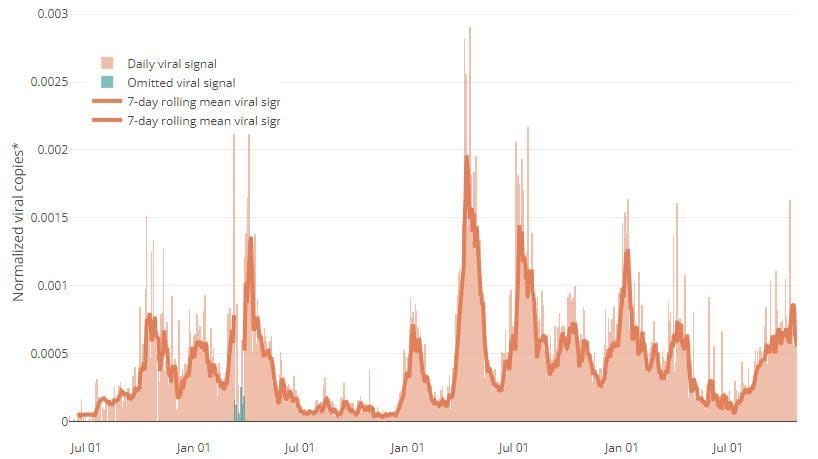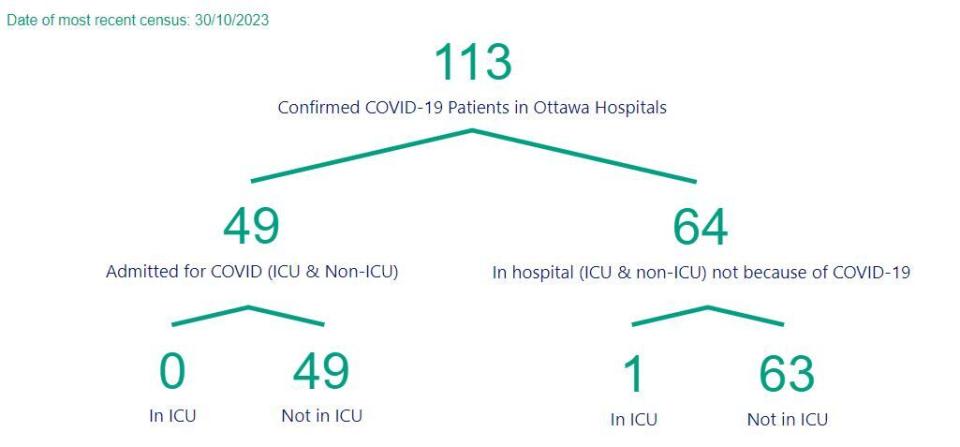Pressure on health-care system eases thanks to improved respiratory virus indicators

Recent developments:
Ottawa's COVID-19 numbers are mostly stable.
Its individual trends range from low to high.
For now, its health-care system isn't considered at a high respiratory risk.
Seven more local COVID deaths have been reported.
The latest
The city's COVID-19 numbers to watch are mostly stable at levels ranging from low to high in this week's Ottawa Public Health (OPH) updates.
It has a generally moderate amount of respiratory syncytial virus (RSV) activity and a generally low level of flu, though its flu wastewater reading is seen as high.
For now, OPH says the city's health-care institutions are not at a high risk from respiratory illnesses. It had been a high risk since September, while December through February are always considered high-risk times.
Experts recommend that people cover coughs and sneezes, wear masks, keep their hands and often-touched surfaces clean, stay home when sick and keep up to date with COVID and flu vaccines to help protect themselves and vulnerable people.
Both COVID and flu vaccines are now available for the general public in Ontario.
Wastewater
Data from the research team shows that as of Oct. 26, the average coronavirus wastewater level has been generally stable for about five weeks, with a recent rise that's settled back down.
OPH considers this to be high, down from very high last week.

Researchers have measured and shared the amount of novel coronavirus in Ottawa's wastewater since June 2020. The most recent data is from Oct. 26, 2023. (613covid.ca)
Hospitals
The average number of Ottawa residents in local hospitals for COVID-19 in the last week is stable at 45, with no patients in an ICU.
A separate count — that includes patients who tested positive for COVID after being admitted for other reasons, were admitted for lingering COVID complications and were transferred from other health units — is stable.

Ottawa Public Health has a COVID-19 hospital count that shows all hospital patients who tested positive for COVID, including those admitted for other reasons and who live in other areas. (Ottawa Public Health)
The 16 new patients from the previous week is labelled as low, according to OPH, which is down from moderate.
Tests, outbreaks, deaths and vaccines
The city's weekly average test positivity rate is about 17 per cent, which is stable. OPH says this is a moderate level.
OPH says there are 35 active COVID outbreaks, up from 23 last week. Most outbreaks are in either retirement homes or hospitals. and there are a moderate amount of new outbreaks.
The health unit reported 217 more COVID cases in the last week and two more COVID deaths, both people age 90 or above.
OPH's next monthly COVID vaccination update is expected next week.
Across the region
Spread
The Kingston area's health unit says its COVID trends are stable at moderate to very high levels and it's in a high-risk time for transmission. Flu indicators are low and RSV trends are either low or moderate.
Its average coronavirus wastewater reading is considered high and stable. Other available wastewater trends outside Ottawa are stable in Smiths Falls, Brockville, Hawkesbury and Cornwall.
The average COVID-19 test positivity rate drops from 27 to 17 per cent in the Eastern Ontario Health Unit (EOHU) and is a stable 14 per cent in the Kingston area.
Hospitalizations and deaths
The Kingston area's health unit says it has a very high 26 active COVID-19 patients in its hospitals, including anyone living in a different health unit. The province has reported that area's 126th overall COVID death.
The number of hospitalizations in Leeds, Grenville and Lanark (LGL) counties drops to three and the EOHU's drop to seven.
Hastings Prince Edward (HPE) Public Health, like Ottawa, gives a weekly hospitalization average. It rises from five to 13.
Western Quebec has a stable 74 hospital patients with COVID.
Three more EOHU residents with COVID have died for a total of 318. LGL reports their 169th total death, the 26th this year.


